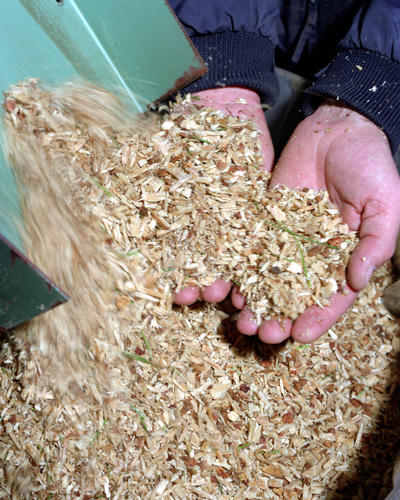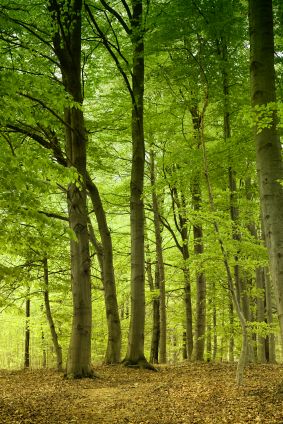Arising from increased environmental awareness and the high cost of fossil fuels, wood energy has become a current topic for policymakers and a potential new market for forest growers. Forests have always been an important renewable resource for solid-wood and paper products; however, more interest is growing in the potential for its use as a clean energy source and as a means for carbon sequestration.
Woody Biomass
 Biomass is a term to describe plant materials, especially those that can be converted to some form of energy or fuel. Woody biomass includes cordwood, limbwood, wood chips, bark, sawdust, forest residues and charcoal. They are attractive sources of energy because they are renewable, they don't come from fossil fuels and they are considered carbon-neutral, meaning that the carbon released when these materials are used for energy is absorbed at about the same rate by the plant materials grown to replace them. Interest in using wood for energy stems largely from the fact that wood is a locally produced, renewable resource that is readily available in much of the country. Wood can be stored in many forms - firewood, chips and even pellets - making wood available for use year-round. It has the potential to play an important role in reducing our country's dependence on oil, and there is considerable interest in how to make this endeavor feasible in both industry and government.
Biomass is a term to describe plant materials, especially those that can be converted to some form of energy or fuel. Woody biomass includes cordwood, limbwood, wood chips, bark, sawdust, forest residues and charcoal. They are attractive sources of energy because they are renewable, they don't come from fossil fuels and they are considered carbon-neutral, meaning that the carbon released when these materials are used for energy is absorbed at about the same rate by the plant materials grown to replace them. Interest in using wood for energy stems largely from the fact that wood is a locally produced, renewable resource that is readily available in much of the country. Wood can be stored in many forms - firewood, chips and even pellets - making wood available for use year-round. It has the potential to play an important role in reducing our country's dependence on oil, and there is considerable interest in how to make this endeavor feasible in both industry and government.
A recent publication entitled Recommendations for the Harvesting of Woody Biomass contains guidelines for the protection of water quality, wildlife habitat, native species and site productivity while harvesting woody biomass. The recommendations were prepared as a collaborative effort between key partners including the Kentucky Division of Forestry, Kentucky Department for Fish and Wildlife Resources, Kentucky Division of Water, Kentucky Division of Conservation, Kentucky State Nature Preserves Commission, University of Kentucky Department of Forestry, U.S. Forest Service and U.S. Fish and Wildlife Service.
Before a logger can start thinking about delivering woody biomass from a harvesting operation and before forestland owners can start thinking about making a profit from biomass; a market must exist. Successful, sustainable markets involve, long-term commitments from both buyers and sellers and both sides must make money. The following questions may help you determine if a wood-to-energy facility might have a future as an energy source in your area.
Is there a sufficient woody biomass supply?
Biomass can come from harvesting operations or as byproducts from wood industries such as sawmills or furniture manufacturers, but regardless of the source, when it is used for energy, it has to be available year-round and in consistent amounts. The source of biomass used for energy has to be fairly close to the power generating facility; otherwise, the cost of hauling it will approach the energy value of the woody debris.
Is sufficient land available for an energy farm?
Some biomass is available from conventional sawtimber harvests and forest practices such as timber stand improvement or from municipal tree removals. In some cases, these sources might generate enough material to sustain continuous power generation. In other areas, this may not be the case and it must be determined whether the community would be willing to support landowners who might choose to grow fast-growing trees exclusively for energy use to provide a dependable source of woody biomass for an energy facility (an "energy farm").
Are the economics of obtaining the woody biomass attractive?
Even though some waste material is inevitably produced by local wood industries, these material still have value for other uses; they may be used on-site for heat generation or horse bedding, mulch or pulp chips. What is needed is an abundant, clean and reliable source of unused wood.
Is there an increasing demand for power or steam locally?
Is an industrial park or new municipal building in your community's plans? Are there power facilities in your area that can sell electricity on the grid? If conversion of biomass to alcohol is contemplated, a community will need an ample supply of water and good transportation access.
Are investors interested in erecting the power generating or conversion facilities required?
This has already occurred in many regions of the U.S. and several facilities currently exist in Kentucky. These facilities produce pellets and sawdust but many more of these facilities are necessary to produce what is currently needed.
Where can I find more information about converting wood to energy?
Please visit the following Web sites:
Carbon Sequestration
 Carbon sequestration is the process through which agricultural and forestry practices remove carbon dioxide (CO2) from the atmosphere. The storage of CO2 or other forms of carbon can help mitigate the effects of greenhouse gases. Forest landowners can potentially generate additional income from stored carbon on their managed forestlands.
Carbon sequestration is the process through which agricultural and forestry practices remove carbon dioxide (CO2) from the atmosphere. The storage of CO2 or other forms of carbon can help mitigate the effects of greenhouse gases. Forest landowners can potentially generate additional income from stored carbon on their managed forestlands.